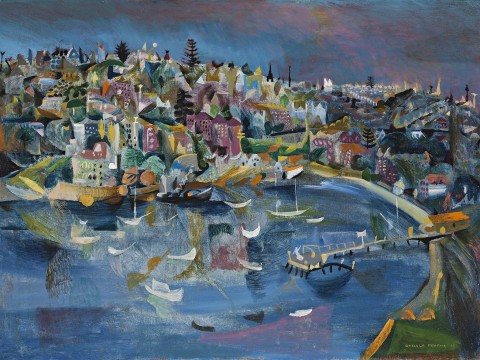DOUBLE BAY, 1956
DONALD FRIEND
oil on canvas
77.0 x 102.0 cm
signed and dated lower right: DONALD FRIEND 56
Private collection
Christie’s, Sydney, 26 October 1987, lot 684
Private collection, Sydney
Two Exhibitions: Russell Drysdale and Donald Friend, Macquarie Galleries, Sydney, 8 – 27 May 1957, cat. 13
‘Drawings by Drysdale. Paintings by Friend.’, Sydney Morning Herald, Sydney, 8 May 1957, p. 2
Double Bay, 1956, is a painting which celebrates the enduring friendship between Donald Friend and Russell ‘Tas’ Drysdale, one which stretched back to the earliest days of World War Two. In the later 1940s, the two artists spent time together painting in the former gold mining town of Hill End in New South Wales, and many of the works they produced there are now highlights within the canon of Australian mid-century art. In 1947, Friend bought a cottage in the village and during the 1950s would return for extended periods in between bouts of immersive travel interstate and overseas. On his frequent visits to Sydney, he would often stay at the Drysdales’ house at 29 Sutherland Crescent, Darling Point. On moving there in 1952, ‘Tas’ had undertaken renovations to ‘two small rooms (which) were turned into a large studio’.1 The view from here took in the entire sweep of Double Bay, an aspect which inspired Friend when he stayed in August 1956 working prodigiously ‘every day … in the glorious big studio, sometimes from eight in the morning until the light failed’.2 He took with him four large canvases, one which he prepared for ‘an Archibald (Prize) portrait, one for a Blake (Prize for Religious Art)’.3 The other two, including the painting on offer here, were transmuted into joyous interpretations of the scene beyond the windows.
Double Bay is set between the wealthy enclaves of Point Piper and Darling Point and gets its name from the small promontory which bisects it. In the early days of European settlement, the colony’s elite started building mansions there and its continuing reputation as a prosperous suburb began. The enviable harbourside position gave rise to a profusion of pleasure craft traversing its waters and in the 1930s, the foreshore was upgraded to support these activities, including the building of a stone sea wall at the edge of Steyne Park, visible in the lower right of Double Bay. Friend was a former resident in the area having lived in 1946 at ‘Merioola’, an artist’s colony located near the diagonal row of white marks at the top of the canvas, and his lingering affection for the locale is evident. Behind the boats and the small sandy beach, the cacophony of houses and apartments clutter back up the hill towards New South Head Road, their architectural forms punctuated by bursts of colour indicative of the bougainvillea, jacaranda and flame trees which grow in abundance. Technically, Friend was experimenting with a form of semi-abstraction that he called ‘topo-diffusionism’, elements of which can be seen in his treatment of the dissolving reflections on the waters of the Bay, emphasised by gestural brush marks and unexpected colour contrasts.
Friend returned to Hill End in September 1956 and worked solidly towards a proposed two-person exhibition with Drysdale to be held at the Macquarie Galleries the following year. At the core of his production were the ‘new disintegrated abstract canvases … (and) those big views of Double Bay (from) when I was staying at the Drysdales’.4 Friend never tired of the optimistic energy that the scene transmitted and in 1968, he exhibited a further twelve studies of Double Bay at Von Bertouch Galleries in Newcastle, again based on the view from that perfectly located studio.
1. Klepac, L., The Life and Work of Russell Drysdale, Bay Books, Sydney, p. 133
2. Hetherington, P. (ed.), The Diaries of Donald Friend: volume 3, National Library of Australia, Canberra, 2005, p. 345
3. ibid., p. 337. Friend had won the Blake Prize the previous year with St John and Scenes from the Apocalypse.
4. ibid.
ANDREW GAYNOR
